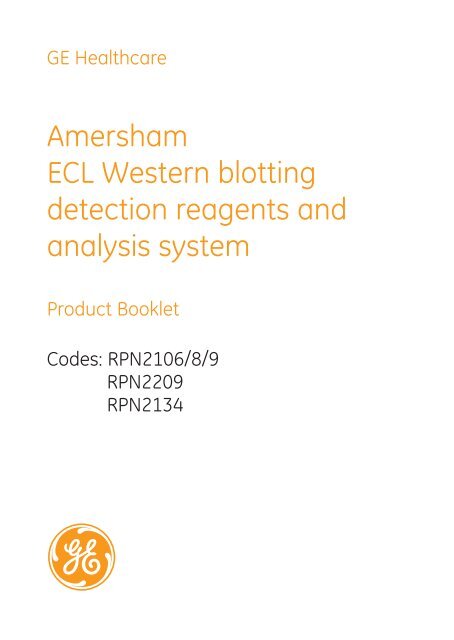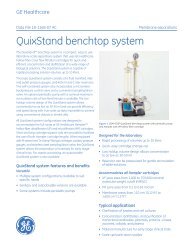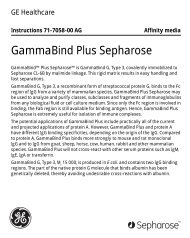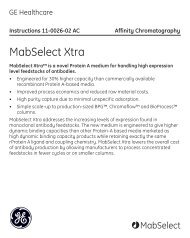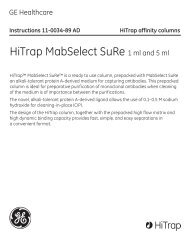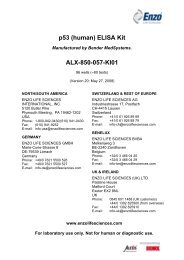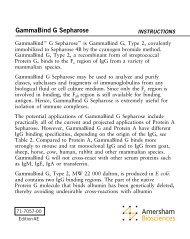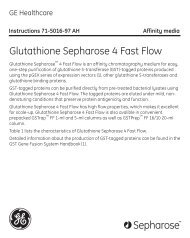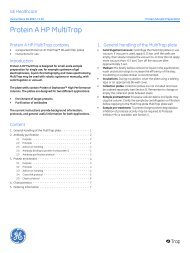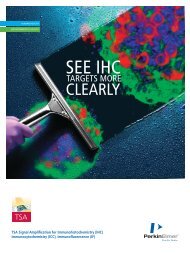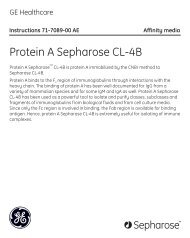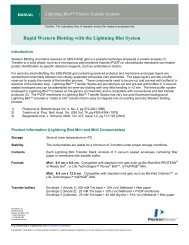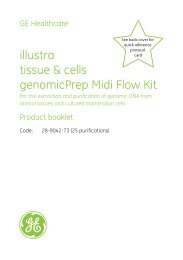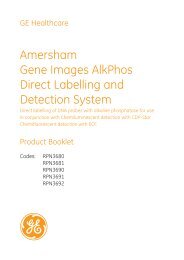Amersham ECL Western blotting detection reagents and analysis ...
Amersham ECL Western blotting detection reagents and analysis ...
Amersham ECL Western blotting detection reagents and analysis ...
You also want an ePaper? Increase the reach of your titles
YUMPU automatically turns print PDFs into web optimized ePapers that Google loves.
GE Healthcare<strong>Amersham</strong><strong>ECL</strong> <strong>Western</strong> <strong>blotting</strong><strong>detection</strong> <strong>reagents</strong> <strong>and</strong><strong>analysis</strong> systemProduct BookletCodes: RPN2106/8/9RPN2209RPN2134
Page finder1. Legal 32. H<strong>and</strong>ling 42.1. Safety warnings <strong>and</strong> precautions 42.2. Storage 42.3. Expiry 43. Components 53.1. Other materials required 54. Description 84.1. Principles of <strong>ECL</strong> <strong>Western</strong> Blotting 84.2. Principles of <strong>ECL</strong> <strong>detection</strong> 95. Critical parameters 116. Protocols 136.1. Flow diagram 136.2. Detailed protocol <strong>and</strong> notes 136.3. Electrophoresis <strong>and</strong> <strong>blotting</strong> 146.4. Blocking the membrane 146.5. Primary antibody incubation 156.6. Secondary antibodsy incubation 166.7. Streptavidin bridge incubation 176.8. Detection 187. Additional information 207.1. Reprobing membranes 207.2. Stripping <strong>and</strong> reporting membranes 207.3. Rapid immuno<strong>detection</strong> protocol 217.4. Determination of optimum antibody concentration 237.5. Quantification of proteins on <strong>ECL</strong> <strong>Western</strong> blots 257.6. Use of <strong>ECL</strong> protein molecular weight markers 298. Troubleshooting guide 349. Quality control 3710. References 3811. Related products 392
1. LegalGE, imagination at work <strong>and</strong> GE monogram are trademarks ofGeneral Electric Company.<strong>Amersham</strong>, <strong>ECL</strong>, <strong>ECL</strong> Plus, Hybond, Hypercassette, Hyperfilm,Hypertorch, Hyperprocessor, Imagemaster, Rainbow <strong>and</strong> Sensitizeare trademarks of GE Healthcare Companies.<strong>ECL</strong> Plus <strong>Western</strong> <strong>blotting</strong> <strong>detection</strong> <strong>reagents</strong> are manufactured forGE Healthcare by Lumigen Inc. This component is covered by USpatent numbers 5491072 <strong>and</strong> 5593845 <strong>and</strong> foreign equivalents <strong>and</strong>is sold under licence from Lumigen Inc.All third party trademarks are the property of their respectiveowners.© 2002–2009 General Electric Company – All rights reserved.Previously published 2002.All goods <strong>and</strong> services are sold subject to the terms <strong>and</strong> conditionsof sale of the company within GE Healthcare which supplies them.A copy of these terms <strong>and</strong> conditions is available on request.Contact your local GE Healthcare representative for the most currentinformation.http://www.gelifesciences.comGE Healthcare UK Limited.<strong>Amersham</strong> Place,Little Chalfont, Buckinghamshire,HP7 9NA, UK3
2. H<strong>and</strong>ling2.1. Safety warnings<strong>and</strong> precautionsWarning: For research useonly. Not recommendedor intended for diagnosisof disease in humans oranimals. Do not use internallyor externally in humans oranimals.All chemicals should beconsidered as potentiallyhazardous. We thereforerecommend that this product ish<strong>and</strong>led only by those personswho have been trained inlaboratory techniques <strong>and</strong>that it is used in accordancewith the principles of goodlaboratory practice. Wearsuitable protective clothingsuch as laboratory overalls,safety glasses <strong>and</strong> gloves.Care should be taken to avoidcontact with skin or eyes. Inthe case of contact with skinor eyes wash immediatelywith water. See material safetydata sheet(s) <strong>and</strong>/or safetystatement(s) for specific advice.You are reminded that certaincomponents in the solutionsmay cause bleaching oncontact with skin.Note: The protocol requires theuse of Hydrochloric acid.Warning: Hydrochloric Acidcauses burns <strong>and</strong> is anirritant. Please follow themanufacturer’s safety datasheet relating to the safeh<strong>and</strong>ling <strong>and</strong> use of thismaterial.2.2. StorageOn receipt all componentsshould be stored in arefrigerator at 2–8°C2.3. ExpiryThe components of theseproducts are stable untilexpiry when stored under therecommended conditions.4
3. ComponentsRPN2106 <strong>ECL</strong> <strong>Western</strong>Blotting Detection Reagents:Detection reagent 1 250 mlDetection reagent 2 250 mlSufficient for 4000 cm 2membraneRPN2209 <strong>ECL</strong> <strong>Western</strong> BlottingDetection Reagents:Detection reagent 1 125 mlDetection reagent 2 125 mlSufficient for 2000 cm 2membraneRPN2109 <strong>ECL</strong> <strong>Western</strong> BlottingDetection Reagents:Detection reagent 1 62.5 mlDetection reagent 2 62.5 mlSufficient for 1000 cm 2membraneRPN2134 <strong>ECL</strong> <strong>Western</strong> BlottingDetection Reagents:RPN2209 × 3Sufficient for 6000 cm 2membraneRPN2108 <strong>ECL</strong> <strong>Western</strong> BlottingAnalysis System:Detection reagent 1 62.5 mlDetection reagent 2 62.5 mlMouse IgG, HorseradishPeroxidase-linked wholeantibody (from sheep), 100 µlRabbit IgG, HorseradishPeroxidase-linked wholeantibody (from donkey), 100 µlBlocking reagent, 5 gSufficient for 10 blots10 cm × 10 cmFor the <strong>detection</strong> of eithermouse or rabbit membranebound primary antibodies.3.1. Other materialsrequiredEquipmentElectrophoresis <strong>and</strong> <strong>blotting</strong>apparatus (for <strong>Western</strong> blots)Blotting membrane,recommend Hybond <strong>ECL</strong>(nitrocellulose) from GEHealthcareOrbital shakerForceps with rounded, nonserratedtipsX-ray film cassettes,recommend Hypercassettefrom GE Healthcare5
TimerFilm, recommend Hyperfilm<strong>ECL</strong>, film developing facility <strong>and</strong><strong>reagents</strong> from GE HealthcareReagentsTris base (Tris(Hydroxymethyl)Aminomethane)Sodium ChlorideHydrochloric Acid (1 M <strong>and</strong> 5 M)Tween 20Immuno<strong>detection</strong> <strong>reagents</strong> (ifusing RPN2106 <strong>and</strong> RPN2109)Distilled waterDisodium HydrogenOrthophosphate Anhydrous(Na 2HPO 4)Sodium DihydrogenOrthophosphate(NaH 2PO 4.2H 20)Buffers <strong>and</strong> working solutionsThe chemical <strong>reagents</strong>required for these solutions areavailable from GE Healthcare<strong>and</strong> are detailed in the currentcatalogue.Phosphate buffered saline(PBS) pH 7.5:11.5 g Disodium HydrogenOrthophosphate Anhydrous(80 mM)2.96 g Sodium DihydrogenOrthophosphate (20 mM) 5.84 gSodium Chloride (100 mM)Dilute to 1000 ml with distilledwater. Check pH.Tris-buffered saline (TBS)pH 7.68 g Sodium Chloride20 ml 1 M Tris HCl, pH 7.6Dilute to 1000 ml with distilledwater. Check pH.Diluent <strong>and</strong> wash bufferPBS Tween (PBS-T) <strong>and</strong> TBSTween (TBS-T)Dilute required volume of Tween20 in the corresponding buffer.A 0.1% Tween 20 concentrationin PBS or TBS is suitable formost <strong>blotting</strong> applications.Storage of buffers oncepreparedAll buffers should be stable forat least 3 months if preparedin advance <strong>and</strong> stored at roomtemperature, although storagein a refrigerator (2–8°C) may benecessary to avoid microbialspoilage.6
Sodium Azide is notrecommended for use as abacteriocide.Working solutions for <strong>ECL</strong>immuno<strong>detection</strong>Membrane blocking agent:GE Healthcare recommendsthe blocking reagent supplied(<strong>ECL</strong> Blocking Agent, RPN2125)or substitute with non-fat driedmilk dissolved in PBS-T or TBS-T;5 g per 100 ml (5%).Immuno<strong>detection</strong> <strong>reagents</strong>Primary antibodies / HRP-linkedsecondary antibodiesIt is recommended thatantibody dilutions are optimizedto maximize signal <strong>and</strong>minimize background. Whenusing the secondary antibodiessupplied in RPN2108, a goodstarting dilution is 1:1000.See page 24. For details ofthe recommended <strong>ECL</strong> HRPantibodies see page 39.Biotinylated antibodyIt is recommended that theantibody dilution should beoptimized to suit different<strong>blotting</strong> situations. See page 23.The full range of biotinylatedantibodies can be found inthe current GE Healthcarecatalogue.Storage of working solutionsonce preparedAll working strength solutionsshould be stable for one hour atroom temperature. For longerperiods it is recommended thatthey be kept in a refrigerator(2–8°C). For reproducibleperformance equilibrate toroom temperature before use.7
Secondary Ab-HRPPeracidOxidizedproductProteinPrimary AbOxidizedformof enzyme+luminol+enhancerLightHybond <strong>ECL</strong>Hyperfilm <strong>ECL</strong>Figure 1. Principles of <strong>ECL</strong> <strong>Western</strong> <strong>blotting</strong>4.2. Principles of <strong>ECL</strong> <strong>detection</strong>Luminescence is defined as the emission of light resulting fromthe dissipation of energy from a substance in an excited state. Inchemiluminescence the excitation is effected by a chemical reaction.The chemical reactions of cyclic Diacylhydrazides such as luminolhave been widely used in chemical <strong>analysis</strong> (1, 2) <strong>and</strong> extensivelystudied (3, 4). One of the most clearly understood systems is theHRP/Hydrogen Peroxide catalyzed oxidation of luminol in alkalineconditions. Immediately following oxidation, the luminol is inan excited state which then decays to ground state via a lightemitting pathway. Enhanced chemiluminescence (2) is achievedby performing the oxidation of luminol by the HRP in the presenceof chemical enhancers such as phenols. This has the effect ofincreasing the light output approximately 1000 fold <strong>and</strong> extendingthe time of light emission. The light produced by this enhancedchemiluminescent reaction peaks after 5–20 minutes <strong>and</strong> decays9
slowly thereafter with a half life of approximately 60 minutes. Themaximum light emission is at a wavelength of 428 nm which can bedetected by a short exposure to blue-light sensitive autoradiographyfilm for example Hyperfilm <strong>ECL</strong>.OON H H 2o 2+ N 2+ lightPeroxidaseN HO -NH 2ONH 2OO -Figure 2.Light emisionApprox 1h Time<strong>ECL</strong>ChemiluminescenceFigure 3. Graph of light emission versus time, showing the differencebetween chemiluminescence <strong>and</strong> <strong>ECL</strong>.10
5. Critical parametersThe following points are critical:• It is essential to optimize both primary <strong>and</strong> secondary antibodiesfor results with high signal <strong>and</strong> low background due to thesensitive performance of the system. The high sensitivity meansthat much higher dilutions of antibodies are required than areused with other conventional systems such as colorimetric.See page 23 for details of optimization experiments that canbe performed to determine the best concentrations of primary<strong>and</strong> secondary antibodies.• It is necessary to work quickly once the membranes have beenexposed to the <strong>detection</strong> <strong>reagents</strong> in order to capture themaximum signal.• Wear powder-free gloves when h<strong>and</strong>ling <strong>detection</strong> <strong>reagents</strong> <strong>and</strong>film.• Do not use Sodium Azide as a preservative for buffers to be usedin immuno<strong>detection</strong> as it is an inhibitor of HorseradishPeroxidase.• Proper blocking <strong>and</strong> washing of the membranes is critical foroptimum results. It may be necessary to adjust blockingconditions for certain applications.• Do not allow the membranes to dry out during theimmuno<strong>detection</strong> procedure.• When washing, the volume of wash buffer should be as largeas possible; 4 ml of buffer per cm 2 of membrane is suggested.Brief rinses of the membrane in wash buffer before incubatingwill improve washing efficiency.11
• If exposure times of less than 5 seconds are routinely required, itis recommended that the antibodies used are further diluted as itis difficult to perform such short exposures.• Although the ‘working mix’ of the <strong>ECL</strong> <strong>reagents</strong> is stable for upto 1 hour, it is recommended that <strong>reagents</strong> are mixedimmediately before use. In the event that mixed <strong>reagents</strong> needto be left longer than 1 hour before use, store at 2–8°C. Forreproducible performance equilibrate to room temperaturebefore use.12
6. Protocols6.1. Flow diagramSeparate protein sample by electrophoresisTransfer to membraneBlock non-specific sitesIncubate in primary antibodyIncubate in HRPlabelledconjugateIncubate in biotinylatedsecond antibody<strong>ECL</strong> <strong>detection</strong><strong>reagents</strong>Incubate in pre-formedHRP-Streptavidin complexExpose to film<strong>ECL</strong> <strong>detection</strong> <strong>reagents</strong>6.2. Detailed protocol <strong>and</strong> notesThe protocol outlined on the following pages has been developedin our laboratories to be the optimum for both sensitivity <strong>and</strong>convenience. A further rapid immuno<strong>detection</strong> protocol is outlinedon page 21 for situations where time is limiting. Users, however, maywish to adapt the protocols to suit their specific needs, <strong>and</strong> notes<strong>and</strong> a troubleshooting guide are provided to assist with this.13Expose to film
6.3. Electrophoresis <strong>and</strong> <strong>blotting</strong>Protocol1. Perform electrophoresis <strong>and</strong><strong>blotting</strong> according to normaltechniques. Protein shouldbe transferred to Hybond<strong>ECL</strong> or Hybond-P PVDF foroptimum results. Blots maybe used immediately orstored in a desiccator for upto 3 months.6.4. Blocking the membraneProtocol1. Block non-specific bindingsites by immersing themembrane in 5% non-fatdried milk, 0.1% (v/v) Tween20 in PBS14Notes1. Hybond <strong>ECL</strong> should be prewettedin distilled water <strong>and</strong>equilibrated in transfer bufferfor at least 10 minutes before<strong>blotting</strong>.2. Hybond-P PVDF shouldbe pre-wetted in 100%Methanol, washed in distilledwater for 5 minutes <strong>and</strong>equilibrated in transfer bufferfor at least 10 minutes before<strong>blotting</strong>.3. <strong>ECL</strong> is also suitable for usewith supported nitrocellulosesuch as Hybond-C Extra.This membrane should beprepared as for Hybond <strong>ECL</strong>.Notes1. The combination of nonfatdried milk <strong>and</strong> Tweenshould be suitable for mostapplications. Optimum Tween
Protocol1. Continued.or TBS (PBS-T or TBS-T, seepage 6) for one hour atroom temperature on anorbital shaker. Alternatively,membranes may be leftin the blocking solutionovernight in a refrigerator at2–8°C, if more convenient.2. Briefly rinse the membraneusing two changes of washbuffer (see page 6).6.5. Primary antibody incubationProtocol1. Dilute the primary antibody.in PBS-T or TBS-T. The dilutionfactor should be determinedempirically for each antibody.2.Incubate the membrane indiluted primary antibody for1 hour at room temperatureon an orbital shaker.3. Briefly rinse the membranewith two changes of washbuffer <strong>and</strong> then wash themembrane in > 4 ml/cm 2 ofwash buffer for 15 minutesat room temperature.15Notes1. Continued.concentrations will vary tosuit specific experiments,but a 0.1% Tween 20concentration is suitable formost <strong>blotting</strong> applications.2. While washing prepare thediluted primary antibody(section 6.5., step 1)Notes1. Optimization of the antibodydilution can be performed bydot blot <strong>analysis</strong> (see page 23).2. Incubation times <strong>and</strong>temperatures may vary <strong>and</strong>should be optimized for eachantibody. The conditionsindicated are recommendedstarting points.
Protocol4. Wash the membrane for 3 ×5 minutes with fresh changesof wash buffer at roomtemperature.Notes4. While washing prepare thediluted secondary antibody(section 6.6., step 1).6.6. Secondary antibody incubationProtocol1. Dilute the HRP labelledsecondary antibody orbiotinylated antibody inPBS-T or TBS-T. The dilutionfactor should be determinedempirically for each antibody(see page 23).2. Incubate the membranein the diluted secondaryantibody for 1 hour at roomtemperature on an orbitalshaker.3. Briefly rinse the membranewith two changes of washbuffer <strong>and</strong> then wash themembrane in > 4 ml/cm 2 ofwash buffer for 15 minutes atroom temperature.4. Wash the membrane for 3 ×5 minutes with fresh changesof wash buffer at roomtemperature.Notes1. Use either an appropriateHRP labelled secondaryantibody or a biotinylatedsecondary antibody.2. Incubation times <strong>and</strong>temperatures may vary <strong>and</strong>should be optimized for eachantibody. The conditionsindicated are recommendedstarting points.4. If using HRP-labelledsecondary antibody proceeddirectly to step 8 (<strong>detection</strong>)after this wash procedure.16
6.8. DetectionProtocol1. Mix an equal volume of<strong>detection</strong> solution 1 with<strong>detection</strong> solution 2 allowingsufficient total volume tocover the membranes. Thefinal volume required is0.125 ml/cm 2 membrane.2. Drain the excess washbuffer from the washedmembranes <strong>and</strong> place them,protein side up, on a Protocolsheet of SaranWrap orother suitable clean surface.Pipette the mixed <strong>detection</strong>reagent on to the membrane.3. Incubate for 1 minute atroom temperature.4. Drain off excess <strong>detection</strong>reagent by holding themembrane gently withforceps <strong>and</strong> touching theedge against a tissue.Place the blots protein sidedown on to a fresh pieceof SaranWrap, wrap up theblots <strong>and</strong> gently smooth outany air bubbles.Notes1. If the mixed reagent is not tobe used immediately, storeat 2–8°C. For reproducibleperformance equilibrate toroom temperature beforeuse.2. The <strong>reagents</strong> should coverthe entire surface of themembrane, held by surfacetension on to the surface ofthe membrane.4. Close the SaranWraparound the membrane toform an envelope or use analternative, suitable <strong>detection</strong>pocket. Avoid using pressureon the membrane.18
Protocol5. Place the wrapped blots,protein side up, in an X-rayfilm cassette.6. Place a sheet ofautoradiography film (forexample Hyperfilm <strong>ECL</strong>) ontop of the membrane. Closethe cassette <strong>and</strong> expose for15 seconds.7. Remove the film <strong>and</strong>replace with a secondsheet of unexposed film.Develop the first piece offilm immediately, <strong>and</strong> onthe basis of its appearanceestimate how long tocontinue the exposure of thesecond piece of film. Secondexposures can vary from 1minute to 1 hour.Notes5. Ensure that there is no free<strong>detection</strong> reagent in the filmcassette; the film must notget wet.6. This stage should be carriedout in a dark room, using redsafelights. Do not move thefilm while it is being exposed.7. The detected blots can alsobe exposed to Polaroidfilm using the <strong>ECL</strong> minicamera(RPN2069), which isspecifically designed for blotsgenerated from mini-gelapparatus. The <strong>ECL</strong> minicamerais suitable for blotsup to 52 × 77 mm.Images can also be aquiredusing a CCD camera such asImagemaster VDS-CL(18-1130-55).19
7. Additional information7.1. Reprobing membranesFollowing <strong>ECL</strong> <strong>detection</strong> it is possible to reprobe the membraneseveral times to either clarify or confirm results or when small orvaluable samples are being analyzed (5). Sequential reprobing ofmembranes with a variety of antibodies is possible following thesteps below. The membranes may be stored wet <strong>and</strong> wrapped in arefrigerator (2–8°C) after each immuno<strong>detection</strong>.Protocol1.Wash the membrane for 2 ×10 minutes in TBS-T or PBS-Tat room temperature usinglarge volumes of wash buffer.2. Block the membrane in 5%non-fat dried milk in PBS-Tor TBS-T for 1 hour at roomtemperature.3. Repeat the immuno<strong>detection</strong>protocol, stages 6.5. to 6.8.Notes2. Refer to note in section 6.4.,step 1 on page 14.7.2. Stripping <strong>and</strong> reprobing membranesThe complete removal of primary <strong>and</strong> secondary antibodies fromthe membrane is possible following the protocol outlined below.The membranes may be stripped of bound antibodies <strong>and</strong> reprobedseveral times. Membranes should be stored wet wrapped inSaranWrap in a refrigerator (2–8°C) after each immuno<strong>detection</strong>.20
Protocol1. Submerge the membrane instripping buffer (100 mM2-Mercaptoethanol, 2% SDS,62.5 mM Tris-HCl pH 6.7) <strong>and</strong>Protocol incubate at 50°C for30 minutes with occasionalagitation.2. Wash the membrane for 2 ×10 minutes in PBS-T or TBS-Tat room temperature usinglarge volumes of wash buffer.3. Block the membrane byimmersing in 5% Nonfatdried milk in PBS-T orTBS-T for 1 hour at roomtemperature.4. Repeat the immuno<strong>detection</strong>protocol, stages 6.5. to 6.8.Notes1. If more stringent conditionsare required the incubationcan be performed at 70°Cor the incubation timeincreased.2. Membranes may beincubated with <strong>ECL</strong> <strong>detection</strong><strong>reagents</strong> <strong>and</strong> exposed tofilm to ensure removal ofantibodies.7.3. Rapid immuno<strong>detection</strong> protocolIf time is short the following protocol allows the immuno<strong>detection</strong>using HRP-labelled antibodies to be completed in just over 2 hours,compared to 4 hours for the st<strong>and</strong>ard protocol. If desired, theprotocol can be further shortened by also optimizing the primaryantibody for a shortened incubation.Protocol1. Block the membrane in 10%non-fat dried milk in PBS-T orTBS-T for 10 minutes at roomtemperature.21Notes1. This protocol has beenoptimized using 10% non-fatdried milk. Other blocking
Protocol2. Briefly rinse the membranewith Protocol two changes ofwash buffer. (see page 6).3. Dilute the primary antibodyin PBS-T or TBS-T. The dilutionfactor should be determinedempirically for each antibody.4. Incubate the membrane indiluted primary antibody for1 hour at room temperatureon an orbital shaker.5. Briefly rinse the membranewith three changes of washbuffer <strong>and</strong> then wash twicefor 10 minutes in freshchanges of wash buffer, atroom temperature.Notes1. Continued.agents will need to be testedfor their capacity to blockeffectively in a 10 minuteincubation. The short block issuitable for both Nitrocellulose<strong>and</strong> PVDF membranes.2. While washing prepare thediluted primary antibody(step 3).3. Optimization of the antibodydilution can be performed bydot blot <strong>analysis</strong>, (see page 23).4. A further shortening of theimmuno<strong>detection</strong> procedureis possible by increasingthe primary antibodyconcentration, allowing areduction in the incubationtime without compromisingsensitivity.5. While washing, dilute thesecondary antibody. Inorder to maintain the samesensitivity as obtained withthe st<strong>and</strong>ard method, thesecondary antibody shouldbe used at a strongerconcentration. As a22
Protocol6. Incubate the membranein the diluted secondaryantibody for 15 minutes atroom temperature.7. Briefly rinse the membranewith three changes of washbuffer <strong>and</strong> then wash twicefor 10 minutes in freshchanges of wash buffer, atroom temperature.8. Perform the <strong>detection</strong> with<strong>ECL</strong> <strong>reagents</strong> as described onpage 18.Notes5. Continued.guideline, increasing theconcentration by four timesshould maintain the samesensitivity.7.4. Determination of optimum antibodyconcentrationDue to the sensitivity of the <strong>ECL</strong> <strong>detection</strong> <strong>reagents</strong>, optimization ofantibody concentrations is recommended to ensure the best results.In general, lower concentrations of both primary <strong>and</strong> secondaryantibodies are required with <strong>ECL</strong> compared to colorimetric <strong>detection</strong>.Outlined below are protocols for determining optimal antibodyconcentrations.Primary antibodiesDot blots are a quick <strong>and</strong> effective method of determining theoptimum dilution of a primary antibody of unknown concentration.23
Alternatively, a <strong>Western</strong> blot can be prepared <strong>and</strong> then cut intoseveral strips. It should be noted that some antibodies may requirealternative blocking <strong>and</strong> washing steps to the ones suggested below.1.1. Spot a suitable amount of protein sample to a Nitrocellulose orPVDF membrane <strong>and</strong> allow to air dry. Prepare one blot for eachprimary antibody dilution to be tested.1.2. Incubate in blocking solution for 1 hour at room temperaturewith agitation.1.3. Rinse the membranes briefly with two changes of wash buffer.1.4. Prepare several dilutions of primary antibody: e.g Nitrocellulose1/100, 1/500, 1/1000, 1/1500; PVDF 1/500, 1/1000, 1/2500,1/5000. Incubate 1 blot in each dilution for 1 hour at roomtemperature with agitation.1.5. Rinse blots in two changes of wash buffer, then wash for1 × 15 minutes <strong>and</strong> 3 × 5 minutes in fresh changes of wash buffer.1.6. Dilute the secondary antibody (using only one concentration)<strong>and</strong> incubate the membranes for 1 hour at room temperaturewith agitation.1.7. Wash as detailed in step 1.5.1.8. Detect using <strong>ECL</strong> <strong>detection</strong> <strong>reagents</strong> as detailed in section 6.8.of the protocol. The antibody dilution which gives the best signalwith the minimum background should be selected.Secondary antibodiesFor a secondary antibody of unknown activity, a dot blot is alsoeffective.2.1. Prepare dot blots <strong>and</strong> block the membranes as detailed in 1.1.<strong>and</strong> 1.2.2.2. Incubate in diluted primary antibody (using only oneconcentration) for 1 hour at room temperature with agitation.24
2.3. Wash as detailed in step 1.5.2.4. Prepare several dilutions of secondary antibody: e.g.nitrocellulose 1/1000, 1/2500, 1/5000, 1/10 000; PVDF 1/2500,1/5000, 1/10 000, 1/15 000. Incubate 1 blot in each dilution for 1hour at room temperature with agitation.2.5. Wash as detailed in step 1.5.2.6. Detect using <strong>ECL</strong> <strong>detection</strong> <strong>reagents</strong> as detailed in step 6.8. ofthe protocol. The antibody dilution which gives the best signalwith minimum background should be selected.7.5. Quantification of proteins on <strong>ECL</strong> <strong>Western</strong>blotsIt has been demonstrated (17) that Hyperfilm <strong>ECL</strong> exhibits a linearresponse to the light produced from enhanced chemiluminescence.This relationship can be used for the accurate quantification ofproteins of <strong>ECL</strong> <strong>Western</strong> blots, using densitometry. The range overwhich the film response is linear can be extended by pre-flashingthe film prior to exposure, making quantification of lower levels ofprotein, in particular, more accurate. Outlined below are guidelinesto enable quantification of unknown levels of protein.1. The sample containing the protein to be quantified plus a setof st<strong>and</strong>ards (known amounts of the same antigen) are used toprepare a <strong>Western</strong> blot. It is suggested that at least 5 differentst<strong>and</strong>ard dilutions are used. The dilution range should not begreater than one order of magnitude (see example on pages26–27). It is important that the concentration of the protein to bequantified lies within the st<strong>and</strong>ard range. To ensure this, it may beworth running more than one dilution of the protein.2. If desired, the film to be used can be pre-flashed. This is performedusing a modified flash unit such as Sensitize RPN2051 thathas been calibrated (by adjusting its distance from the film), to25
aise the film optical density 0.1 to 0.2 OD units above that ofthe st<strong>and</strong>ard film. The flash duration should be in the region of 1msec.3. The <strong>Western</strong> blot is detected using st<strong>and</strong>ard protocols <strong>and</strong> thenexposed to film. For quantification to be accurate, it is importantthat the light produced is in the linear range of the film. This canbe achieved by making several exposures of different lengths oftime. If the st<strong>and</strong>ard of lowest concentration is only just visible onthe film, then the light from the rest of the st<strong>and</strong>ards should be inthe linear range of the film.4. The films can then be scanned using a densitometer, <strong>and</strong> agraph of peak area against protein concentration plotted. Theconcentration of the protein being quantified can then be read offthis graph, taking into account any dilutions made.ExampleA dilution series of myosin (chicken gizzard) was prepared containing600 ng, 450 ng, 300 ng, 150 ng <strong>and</strong> 60 ng per 10 µl of loading buffer.Two further test samples in the range 60–600 ng were also prepared.Samples were electrophoresed <strong>and</strong> blotted on to Hybond <strong>ECL</strong>.Immuno<strong>detection</strong> was performed using anti-myosin at a 1:20 dilution,anti-mouse Ig-HRP at a 1:3000 dilution <strong>and</strong> <strong>ECL</strong> <strong>detection</strong> <strong>reagents</strong>.A series of exposures to Hyperfilm <strong>ECL</strong> were made <strong>and</strong> the filmon which the lowest concentration of myosin was just detectablewas used for densitometric <strong>analysis</strong>. The film was scanned usinga densitometer <strong>and</strong> a graph was plotted of peak area (OD units)against myosin concentration. The concentrations of the two testsamples were then estimated from the st<strong>and</strong>ard curve.26
Figure 4. <strong>ECL</strong> <strong>detection</strong> of myosin st<strong>and</strong>ard curve <strong>and</strong> myosin testsamples.From left to right: myosin st<strong>and</strong>ards 600 ng, 450 ng, 300 ng, 150 ng,60 ng, myosin test samples 1,2. 15 second exposure to Hyperfilm <strong>ECL</strong>.Table 1. Peak area (OD units) for myosin st<strong>and</strong>ards <strong>and</strong> test samples.Myosin samplesPeak area (OD units)St<strong>and</strong>ards 600 ng 2.075450 ng 1.620300 ng 1.149150 ng 0.69260 ng 0.200Test samples 1 0.8652 0.47627
2.42.0Peakarea(OD units)1.61.20.80.400 100 200 300 400 500ng myosinFigure 5. Peak area (OD units) against myosin concentrationTable 2. Comparison of calculated with actual concentration for themyosin test samples.Test sample Actual Calculatedconcentration (ng) concentration (ng)1 240 ng 2352 120 ng 12528
7.6. Use of <strong>ECL</strong> protein molecular weightmarkersThe <strong>ECL</strong> protein molecular weight markers (RPN2107) are amixture of six different proteins labelled with biotin for use in<strong>Western</strong> <strong>blotting</strong> following electrophoresis on a Polyacrylamide gelprepared by the method of Laemmli (6). Incubation of the blot withStreptavidin Horseradish Peroxidase followed by <strong>detection</strong> withthe <strong>ECL</strong> <strong>Western</strong> <strong>blotting</strong> system will result in a ladder of b<strong>and</strong>s ofapproximately equal intensity.Protocol1. Remove 1 µl of markers <strong>and</strong>add to 9 µl of gel loadingbuffer (containing 5%2-β-Mercaptoethanol).2. Heat to 100°C for 4 minutes.Samples may be loaded onto the gel immediately, orstored temporarily on ice.3. Load 10 µl per well.4. Following electrophoresis<strong>and</strong> transfer to nitrocellulosemembranes, membranes areprocessed by st<strong>and</strong>ardNotes1. Prepare dilution freshly, donot store the markers inloading buffer.2. Do not subject the markers tomore than one denaturation.3. A 10 µl loading is sufficientto produce clearly visibleb<strong>and</strong>s after a 15 secondexposure using overnight<strong>blotting</strong> in Towbin buffer (9)<strong>and</strong> st<strong>and</strong>ard <strong>ECL</strong> <strong>Western</strong><strong>blotting</strong> immuno<strong>detection</strong>protocols.4.1. It is strongly advised thatmilk should not be includedin the Streptavidin-HRPincubation. The binding of29
Protocol4. Continued.immuno<strong>detection</strong> protocolsas outlined in the mainprotocol section. If theprotocol used is not a Biotin-Streptavidin system thenStreptavidin-HRP (RPN1231)is added (1:1500) in the finalantibody incubation.5. The membranes are thenwashed <strong>and</strong> detected using<strong>ECL</strong> <strong>reagents</strong> as detailed onpage 18.6. The volume of markersrequired to give optimumresults will depend onthe electro<strong>blotting</strong> <strong>and</strong>immuno<strong>detection</strong> conditionsNotes4.1. Continued.Streptavidin to Biotinis inhibited due to thepresence of endogenousBiotin in the milk,resulting in a muchdecreased signal whendetected by enhancedchemiluminescence.4.2. If cross reactivity isobserved between theStreptavidin-HRP <strong>and</strong> theprotein samples on theblot, it is suggested thatthe lane containing themarkers is removed <strong>and</strong>incubated in Streptavidin-HRP separately. The stripcan then be re-aligned withthe rest of the membranefor <strong>ECL</strong> <strong>detection</strong>.6.1. The loading recommended,will give clearly visibleb<strong>and</strong>s after a 15 secondexposure. If the b<strong>and</strong>s takelonger to appear,30
Protocol6. Continued.used <strong>and</strong> the length ofexposure to film required.The exact loading will haveto be determined for eachapplication.Notes6.1. Continued.the probable cause isinefficient transfer tomembrane. This is mostlikely to be a problem withlarge gels.Transfer should beovernight for tank <strong>blotting</strong>,<strong>and</strong> greater than 1 hourfor semi-dry <strong>blotting</strong>. Thereshould be good contactbetween the gel <strong>and</strong> themembrane during transfer.For tank blots the use ofextra Scotch-brite pads<strong>and</strong> additional securing ofthe transfer cassettes, withrubber b<strong>and</strong>s, will improvetransfer.6.2. Conversely, if the b<strong>and</strong>sproduced are too intenseor a longer exposure wouldbe more convenient, it issuggested that a higherdilution of markers is used.31
Phosphorylase b (97400)Bovine serum Albumin (68000)Ovalbumin (46000)Carbonic Anhydrase (31000)Trypsin inhibitor (20100)Lysozyme (14400)Figure 6. Profile of <strong>ECL</strong> protein molecular weight markers.1 µg sample <strong>ECL</strong> protein molecular weight markers diluted with 9 µlof loading buffer <strong>and</strong> run on a 12% Polyacrylamide gel for 1 hour at150 volts, followed by electro<strong>blotting</strong> on to Hybond <strong>ECL</strong> overnightat 30 volts. Processing of the blot was outlined in the <strong>ECL</strong> <strong>Western</strong><strong>blotting</strong> protocol, using Streptavidin-HRP (RPN1231,1:1500 dilution)<strong>and</strong> <strong>ECL</strong> <strong>Western</strong> <strong>blotting</strong> <strong>detection</strong> <strong>reagents</strong>. The light emission wascaptured using Hyperfilm <strong>ECL</strong> for a 15 second exposure.32
1.00.9Electrophoretic mobility0.80.70.60.50.40.30.20.10.04.0 4.2 4.4 4.6 4.8 5.0Log molecular weightq Trailing edges Leading edgeFigure 7. <strong>ECL</strong> protein molecular weight markers calibration line.33
8. Troubleshooting guideProblem: No signalPossible causes <strong>and</strong> solutions1. Check that transfer equipment is working properly <strong>and</strong> that thecorrect procedure has been followed.2. Check protein transfer by staining the gel <strong>and</strong>/or membrane.3. Some antigens may be affected by the treatments required forelectrophoresis.4. Target protein degradation may occur if the blots are storedincorrectly.5. <strong>ECL</strong> <strong>detection</strong> <strong>reagents</strong> may have become contaminated.6. Incorrect storage of the <strong>ECL</strong> <strong>detection</strong> <strong>reagents</strong> may cause a lossof signal.Problem: Weak signalPossible causes <strong>and</strong> solutions1. Transfer efficiency may have been poor.2. Insufficient protein was loaded on to the gel.3. The concentration of primary <strong>and</strong> secondary antibodies could betoo low; optimization is required.4. Film exposure time may have been too short.Problem: Excessive diffuse signalPossible causes <strong>and</strong> solutions1. Too much protein was loaded onto the gel.2. Electrophoresis <strong>and</strong> transfer protocols may need optimization.3. The concentrations of primary <strong>and</strong> secondary antibodies could betoo high; optimization is required.34
Problem: White (negative) b<strong>and</strong>s on the filmPossible causes <strong>and</strong> solutions1. Negative b<strong>and</strong>s generally occur when protein target is inexcess <strong>and</strong> antibody concentrations are too high. The effect iscaused by substrate depletion. To rectify this either, reduce theamount of target loaded, use lower antibody concentrations or acombination of both.Problem: Uneven, spotted backgroundsPossible causes <strong>and</strong> solutions1. Blotting technique requires optimization.2. Areas of the blot may have dried during some of the incubations.3. Incorrect h<strong>and</strong>ling can lead to contamination on the blots <strong>and</strong>/ormembrane damage, which may cause non-specific signal.Problem: High backgroundsPossible causes <strong>and</strong> solutions1. The concentrations of primary <strong>and</strong> secondary antibodies could betoo high; optimization is required.2. Contamination can be transferred to the blots fromelectrophoresis <strong>and</strong> related equipment used in blot preparation.3. Transfer <strong>and</strong> incubation buffers may have become contaminated<strong>and</strong> require replacing.4. The blocking agent used was not freshly prepared, was too diluteor was incompatible with the application.5. The level of Tween used in the blocking agent was not sufficientfor the application performed.6. The membrane was allowed to dry during some of theincubations.35
Problem: High backgrounds Continued.Possible causes <strong>and</strong> solutions7. The type of membrane used was not compatible with nonradioactivesystems.8. The post antibody washes were not performed for a sufficientperiod of time or were not performed in a high enough volume.9. There was insufficient Tween in the post antibody washes.10. Insufficient changes of post antibody washes were used.11. The film <strong>detection</strong> of the signal was allowed to over expose.12. The level of signal is so high that the film has become completelyoverloaded.36
9. Quality controlEvery batch of <strong>ECL</strong> <strong>detection</strong> <strong>reagents</strong> is functionally tested in a<strong>Western</strong> <strong>blotting</strong> application to ensure minimal batch to batchvariability.37
10. References1. Isaccson, U. <strong>and</strong> Watermark, G., Anal. Chim. Acta. 68, 339–362 (1974).2. Whitehead, T. P. et al., Clin. Chem. 25, 1531–1546 (1979).3. Rosewell, D. F. <strong>and</strong> White, E. H., Methods in Enzymology. 57,Deluca, M. A. (Ed). Academic Press, New York, pp.409–423 (1978).4. Motsenbocker, M. A., J. Biolum. Chemilum. 2, 9–16 (1968).5. Kaufmann, S. H. et al., Anal. Biochem. 161, 89–95 (1987).6. Laemmli U.K., Nature. 227, pp.680-685 1970.7. Hoffman, W. L. <strong>and</strong> Jump, A. A., Anal. Biochem. 181, 318–320 (1989).8. Towbin, H. <strong>and</strong> Gordon, J., J. Immunol. Meth. 72, 313–340 (1984).Related references (electrophoresis <strong>and</strong> <strong>blotting</strong>)9. Gershoni, J. M. <strong>and</strong> Palade, G.E., Anal. Biochem. 131, 1–15 (1983).10. Peluso, R.W. <strong>and</strong> Rosenberg, G.H., Anal. Biochem. 162, 389–398(1987).11. Towbin, H. et al., Proc. Natl. Acad. Sci. (USA) 76, 4350–4354 (1979).12. Gershoni, J. M. <strong>and</strong> Palade, G.E., Anal. Biochem. 124, 396–405(1982).13. Burnette, W. M., Anal. Biochem. 112, 195–203 (1981).14. Bittner, M. et al., Anal. Biochem, 102, 457–471 (1980).15. Lin, W. <strong>and</strong> Kasamatsu, H., Anal. Biochem. 128, 302–311 (1983).16. Andrews, A. T., Electrophoresis: Theory, Techniques <strong>and</strong>Biochemical <strong>and</strong> Clinical Applications, Second Edition in Monographson Physical Biochemistry, edited by A.R. Peacock <strong>and</strong> W. R.Harrington, Oxford Science Publications, (1986).17. Johnstone, A. <strong>and</strong> Thorpe, R., Immunochemistry in Practice.,Blackwell Science Publications, (1982).18. Life Science. 7, 12–13, <strong>Amersham</strong> International plc, (1992).38
<strong>ECL</strong> Plus <strong>Western</strong> Blotting Detection Reagents(sufficient for 1000 cm 2 membrane)<strong>ECL</strong> Plus <strong>Western</strong> Blotting Detection Reagents(sufficient for 3000 cm 2 membrane)RPN2132RPN2133<strong>ECL</strong> PLus <strong>Western</strong> Blotting Reagent PackDoes not contain <strong>detection</strong> <strong>reagents</strong>Anti-mouse IgG, HRP-linked whole antibody(from sheep), 100 µlAnti-rabbit IgG, HRP-linked whole antibody(from donkey), 100 µlBlocking reagent, 5 gSufficient for 10 blots, 10 × 10 cmRPN2124<strong>ECL</strong> Glycoprotein Detection Module25 membrane reactionsOrder <strong>ECL</strong> Detection Reagents separatelyRPN2190<strong>ECL</strong> Protein Biotinylation ModuleOrder <strong>ECL</strong> Detection Reagents separatelyRPN2202<strong>ECL</strong> Protein Biotinylation SystemSufficient for 2000 cm 2 membrane RPN 2203<strong>ECL</strong> Phosphorylation ModuleSufficient for 25 blotsOrder <strong>ECL</strong> Detection Reagents separatelyRPN2220GST <strong>Western</strong> Blotting Detection KitSufficient for 2000cm 2 membraneRPN1237Hypercassette18 × 24 cm RPN1164230 × 40 cm RPN1164410 × 12 inches RPN116505 × 7 inches RPN1164841
GE Healthcare offices:GE Healthcare Bio-Sciences ABBjörkgatan 30, 751 84 Uppsala,SwedenGE Healthcare Europe GmbHMunzinger Strasse 5, D-79111 Freiburg,GermanyGE Healthcare Bio-Sciences Corp.800 Centennial Avenue, P.O. Box 1327,Piscataway, NJ 08855-1327,USAGE Healthcare Bio-Sciences KKSanken Bldg. 3-25-1, Hyakunincho,Shinjuku-ku, Tokyo 169-0073,JapanFor contact information for your local office,please visit: www.gelifesciences.com/contactGE Healthcare UK Limited<strong>Amersham</strong> PlaceLittle Chalfont, Buckinghamshire,HP7 9NA, UKhttp://www.gelifesciences.comGE imagination at work28955347RPN2106PL AD 06/2009
<strong>Amersham</strong><strong>Western</strong> <strong>blotting</strong> protocol summaryProduct protocol card RPN2106/8/9, RPN2209, RPN2134STAGE 1 2 3 4 5 6Electrophoresis Block Wash Primary Wash Biotinylated antibody<strong>and</strong> <strong>blotting</strong> antibody or HRP labelled antibodyREAGENT 5% blocking TBS-T or Diluted in TBS-T or Diluted in TBS-T orreagent in PBS-T TBS-T or PBS-T PBS-TTBS-T or PBS-TPBS-TVOLUME 10 ml 10 ml 10 ml 10 ml 10 mlUSEDTIME Usual 1 hour 1 × 15 min 1 hour 1 × 15 min 20 min–1 hourelectrophoresis <strong>and</strong> 2 × 15 min 2 × 5 min<strong>blotting</strong> timesWarning: For research use only.Not recommended or intended for diagnosisof disease in humans or animals. Do not useinternally or externally in humans or animals.RPN2106PC AD 06/2009
STAGE 7 8 9 10 11Wash - if using HRP Streptavidin Wash Detection Exposurelabelled antibody -HRPomit steps 7 <strong>and</strong> 8REAGENT TBS-T or PBS-T Diluted in TBS-T or Mix the two Drain the reagentTBS-T or PBS-T PBS-T agents 1:1 cover with Saran WrapimmediatelyVOLUME 10 ml 10 ml 10 ml 0.125 ml/cm²USEDTIME 1 × 15 min 20 min–1 hour 1 × 15 min 1 min expose to film for2 × 5 min 4 × 5 min 30 seconds–10 minGE, imagination at work <strong>and</strong> GE monogram are trademarks of General Electric Company.<strong>Amersham</strong> is a trademark of GE Healthcare Companies.All third party trademarks are the property of their respective owners.© 2002–2009 General Electric Company – All rights reserved.Previously published 2002.All goods <strong>and</strong> services are sold subject to the terms <strong>and</strong> conditions of sale of the company within GEHealthcare which supplies them. A copy of these terms <strong>and</strong> conditions is available on request. Contact yourlocal GE Healthcare representative for the most current information.GE imagination at workhttp://www.gelifesciences.comGE Healthcare UK Limited.<strong>Amersham</strong> Place,Little Chalfont, Buckinghamshire,HP7 9NA, UK


